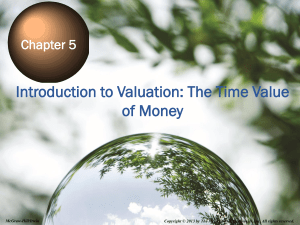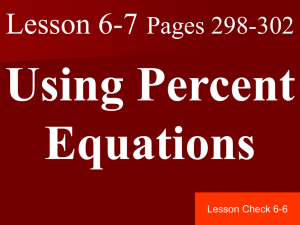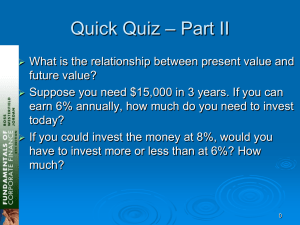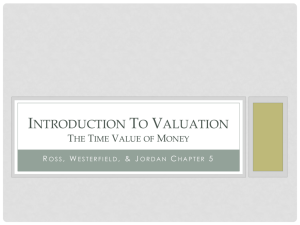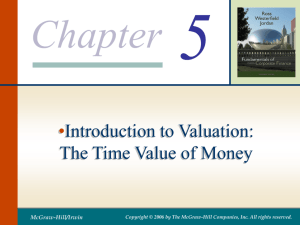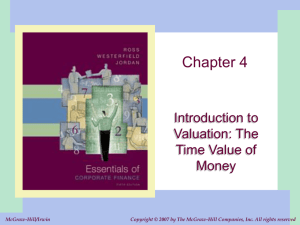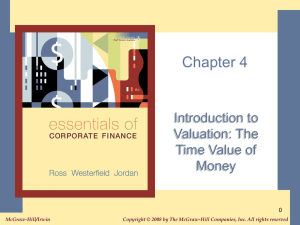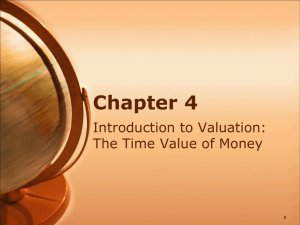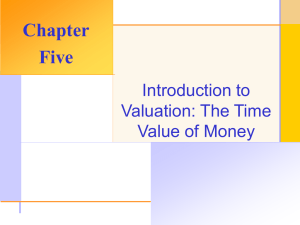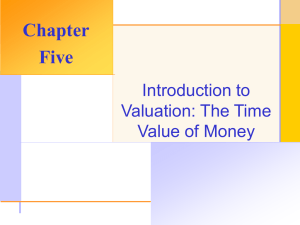Chapter 4
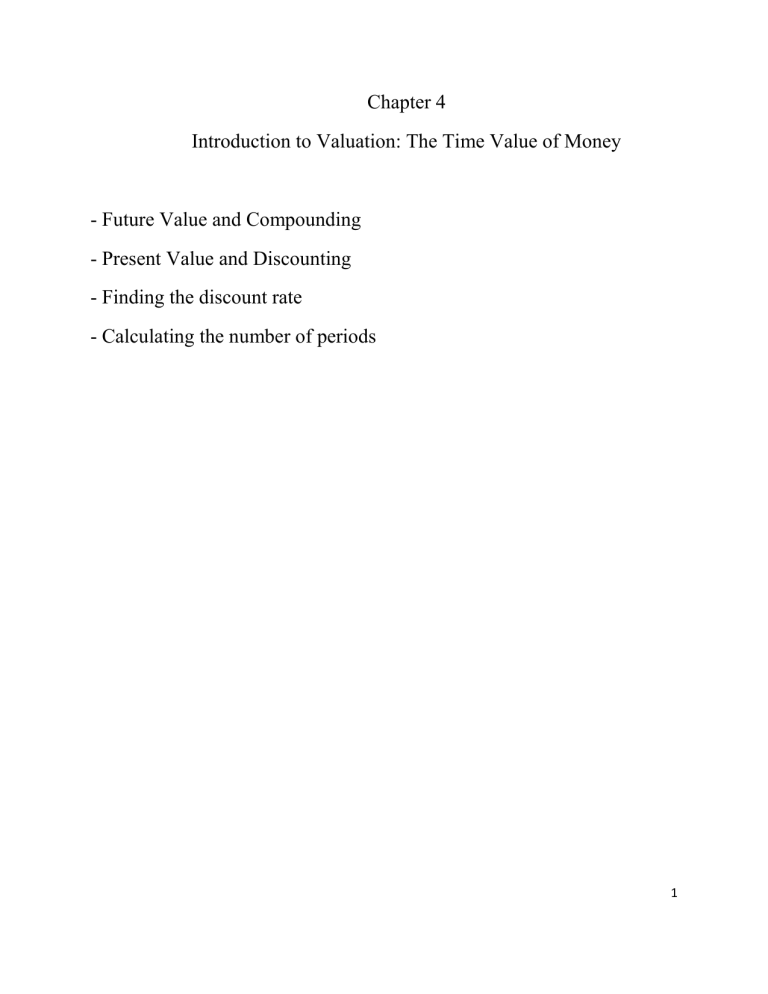
Chapter 4
Introduction to Valuation: The Time Value of Money
- Future Value and Compounding
- Present Value and Discounting
- Finding the discount rate
- Calculating the number of periods
1
Compounding to determine the FV
Would you prefer to have $1 million now or $1 million 10 years from now?
What is the Time Value of Money (TVM)?
$1 received today is worth more than $1 received tomorrow
Why?
$1 received today can be invested to earn interest
Note: The amount of interest earned depends on the rate of return that can be earned on the investment
Other Definitions:
Present value (PV) – value today of future cash flow
Future value (FV)- value of an investment after earning interest
Principal - the amount of your investment.
2
Ex: You have $100 and invest with a 6% interest rate
After 1 year:
Value after 1 year = initial investment times (1+r)
Where r is the interest rate
Value after 1 st year = 100 (1+.06)
= 100 (1.06) = $ 106
After 2 years:
You have $106 after 1 st year
Value after 2 nd year = 106 (1+.06)
= 106 (1.06)
= 100 (1.06) (1.06)
= 100 (1.06) 2
In general:
FV = PV (1+r) t
Where:
FV = future value
PV = present value r = period interest rate, expressed as a decimal t = number of periods
Note: (1 + r) t = Future value interest factor
3
This is called compound interest – interest is earned on principal and on interest received
As opposed to simple interest – interest earned only on the original principal
Ex: If you put $215 in the bank at an interest rate of 5%, how much will you have in 12 years?
FV = PV (1+r) t
= 215 (1.05) 12 = $ 386.11
4
Ex 2: Suppose you invest the $1,000 at 5 percent interest for 5 years.
How much would you have using simple and compounded interest?
Compound interest: FV =$1,000(1.05) (1.05) (1.05) (1.05) (1.05)
=$1,000(1.05) 5 = $1,276.28
Simple interest: (only receive interest on original principal)
Year 1: 5% of $1000 = $50 + $1000 = $1050
Year 2: 5% of $1000 = $50 + $1050 = $1100
Year 3: 5% of $1000 = $50 + $1100 = $1150
Year 4: 5% of $1000 = $50 + $1150= $1200
Year 5: 5% of $1000 = $50 + $1200 = $1250
Or the easy way to calculate simple interest for t years:
$1,000 + $1,000 (.05)(5) = $1,250
The difference between simple and compounded-- $26.28.
Ex 3: Suppose you had a relative deposit $10 at 5.5% interest 200 years ago. How much would the investment be worth today sith simple and compounded interest?
Compound interest: FV = $10(1.055) 200 = $447,189.84
Simple interest: $10 + $10 (.055) (200) = $120
- Compounding added $447,069.84 to the value of the investment
Note: The effect of compounding is small for a small number of periods , but increases as the number of periods increases.
5
Figure 4.1
6
Figure 4.2
7
Calculator Keys
•
Texas Instruments BA-II Plus
–
FV = future value
–
PV = present value
–
I/Y = period interest rate
•
P/Y must equal 1 for the I/Y to be the period rate
•
Interest is entered as a percent, not a decimal
–
N = number of periods
–
Remember to clear the registers (CLR TVM) before (and after) each problem
–
Other calculators are similar in format
8
Ex: A bank pays you 2% on your savings but the interest is compounded annually for 2 years.
Formula: FV = PV(1 + r) t
FV = 1,000(1 + .02) 2 FV = 1,000(1.0404) FV = $1,040.40
With financial calculator:
Input the following: PV = -1,000 n = 2 i = 2
9
We can also use the FV formula as a General Growth Formula
FV = PV (1+r) t
Ex: Suppose your company expects to increase unit sales of widgets by 15% per year for the next 5 years. If you currently sell 3 million widgets in one year, how many widgets do you expect to sell during the fifth year?
FV = 3,000,000(1.15) 5 = 6,034,072
10
Discounting to determine the Present Value
Most financial management decisions involve PV rather than FV.
For example, a financial manager who is considering the purchase of an asset wants to know what it is worth now rather than at a future date
- The reason this asset has value is because it will produce a stream of income or other future cash benefits.
- To determine its value today we have to discount or reduce the future benefits to their present value.
• discounting, - finding the present value of some future amount.
• the “value” of something, → the present value unless we specifically indicate that we want the future value.
We know: FV = PV(1+r)
Using algebra: PV = FV
(1+r) t t discount factor – measures the present value of $1 received in year t also called the present value interest factor (PVIF)
PVIF (r, t) = 1/(1+r) t
11
Ex. 1: A bank agrees to pay you an 8% return for the use of your money and will return $1,000 to you at the end of one year. How much should we invest today (the present value)?
PV = FV
(1+r) t In this case t=1
PV = 1,000 x [1/1.08)] PV = 1,000 x .9259 PV = $925.90
On the calculator: FV = 1,000, n = 1, r = 8, CPT PV = -926.00
Ex 2: How much $ would I have to put in the bank today at 4% interest if I want to have $2000 in 7 years to buy a computer?
PV = 2000/(1.04) 7 = 2000/1.32 = $1515.15
If you earn 4% interest, you would need to initially put $1515.15 in the bank in order to have $2000 in 7 years.
12
Ex. 3: You want to begin saving for your daughter’s college education and you estimate that she will need $150,000 in 17 years. If you feel confident that you can earn 8% per year, how much do you need to invest today?
PV = $150,000 / (1.08) 17 = $40,540.34
Ex 4: Your parents set up a trust fund for you 10 years ago that is now worth $19,671.51. If the fund earned 7% per year, how much did your parents invest?
PV = $19,671.51 / (1.07) 10 = $10,000
Important PV Relationships:
1.) For a given interest rate, the longer the time period, the lower the present value (ceteris paribus: all else equal)
What is the present value of $500 to be received in 5 years? 10 years? The discount rate is 10%.
–
5 years: PV = $500 / (1.1) 5 = $310.46
–
10 years: PV = $500 / (1.1) 10 = $192.77
13
2.) For a given time period, the higher the interest rate, the smaller the present value (ceteris paribus)
–
What is the present value of $500 received in 5 years if the interest rate is 10%? 15%?
•
Rate = 10%: PV = $500 / (1.1) 5 = $310.46
•
Rate = 15%; PV = $500 / (1.15) 5 = $248.59
Figure 4.3
14
Note: In the FV equation there are 4 variables:
1) FV 2) PV 3) r 4) t
Each could be the unknown. We’ve looked at 1) & 2) as unknown
Also note: If you are using a financial calculator, be sure to remember the sign convention or you will receive an error when solving for r or t
15
Finding r:
Discount Rate -- the implied interest rate is in an investment, r
Recall: FV = PV(1 + r) t solve for r:
FV = (1 + r) t
PV
(FV / PV) 1/t = 1 + r r = (FV / PV) 1/t – 1
Note: If you are using formulas, you will want to make use of both the y x and the 1/x keys
Ex 1: You are looking at an investment that will pay $1,200 in 5 years if you invest $1,000 today. What is the implied rate of interest? r = ($1,200 / $1,000) 1/5 – 1 = .03714 = 3.714%
On the Calculator – the sign convention matters!!!
•
N = 5
•
PV = -1,000 (you pay $1,000 today)
•
FV = 1,200 (you receive $1,200 in 5 years)
•
CPT I/Y = 3.714%
16
Ex. 2: Suppose you are offered an investment that will allow you to double your money in 6 years. You have $10,000 to invest. What is the implied rate of interest? r = ($20,000 / $10,000) 1/6 – 1 = .122462 = 12.25%
Ex. 3: Suppose you have a 1-year old son and you want to provide
$75,000 in 17 years toward his college education. You currently have
$5,000 to invest. What interest rate must you earn to have the $75,000 when you need it? r = ($75,000 / $5,000) 1/17 – 1 = .172686 = 17.27%
17
Finding the Number of Periods (t)
Start with basic equation and solve for t (remember your logs)
FV = PV(1 + r) t
FV/PV= (1 + r) t Recall Rule of logs: ln a b = b ln a ln (FV/PV)= ln (1 + r) t ln (FV/PV)= t ln (1 + r) t = ln(FV / PV) / ln(1 + r)
You can use the financial keys on the calculator as well. Just remember the sign convention.
Ex. 1: You want to purchase a new car and you are willing to pay
$20,000. If you can invest at 10% per year and you currently have
$15,000, how long will it be before you have enough money to pay cash for the car? t = ln($20,000 / $15,000) / ln(1.1) = 3.02 years
18
Ex. 2: Suppose you want to buy a new house. You currently have
$15,000 and you figure you need to have a 10% down payment plus an additional 5% in closing costs. If the type of house you want costs about
$150,000 and you can earn 7.5% per year, how long will it be before you have enough money for the down payment and closing costs?
How much do you need to have in the future?
–
Down payment = .1($150,000) = $15,000
–
Closing costs = .05($150,000 – 15,000) = $6,750
–
Total needed = $15,000 + 6,750 = $21,750
Compute the number of periods
–
PV = -15,000
–
FV = 21,750
–
I/Y = 7.5
–
CPT N = 5.14 years
Using the formula
– t = ln($21,750 / $15,000) / ln(1.075) = 5.14 years
19
Example: Spreadsheet Strategies
Use the following formulas for TVM calculations
–
FV(rate,nper,pmt,pv)
–
PV(rate,nper,pmt,fv)
–
RATE(nper,pmt,pv,fv)
–
NPER(rate,pmt,pv,fv)
The formula icon is very useful when you can’t remember the exact formula
Click on the Excel icon to open a spreadsheet containing four different examples.
Example: Work the Web
Many financial calculators are available online
Click on the web surfer to go to the present value portion of the
Moneychimp web site and work the following example:
–
You need $40,000 in 15 years. If you can earn 9.8% interest, how much do you need to invest today?
–
You should get $9,841
20
